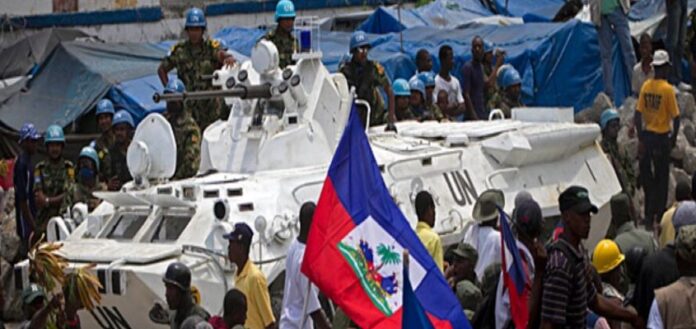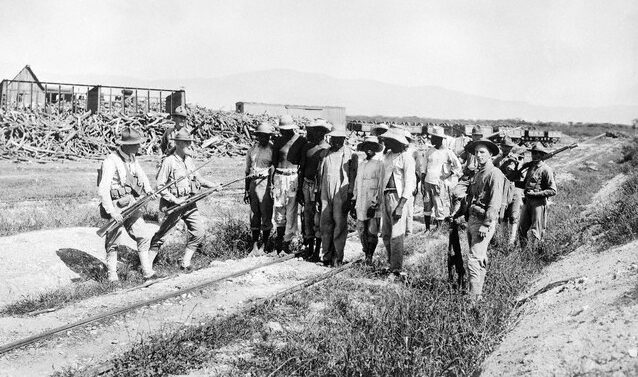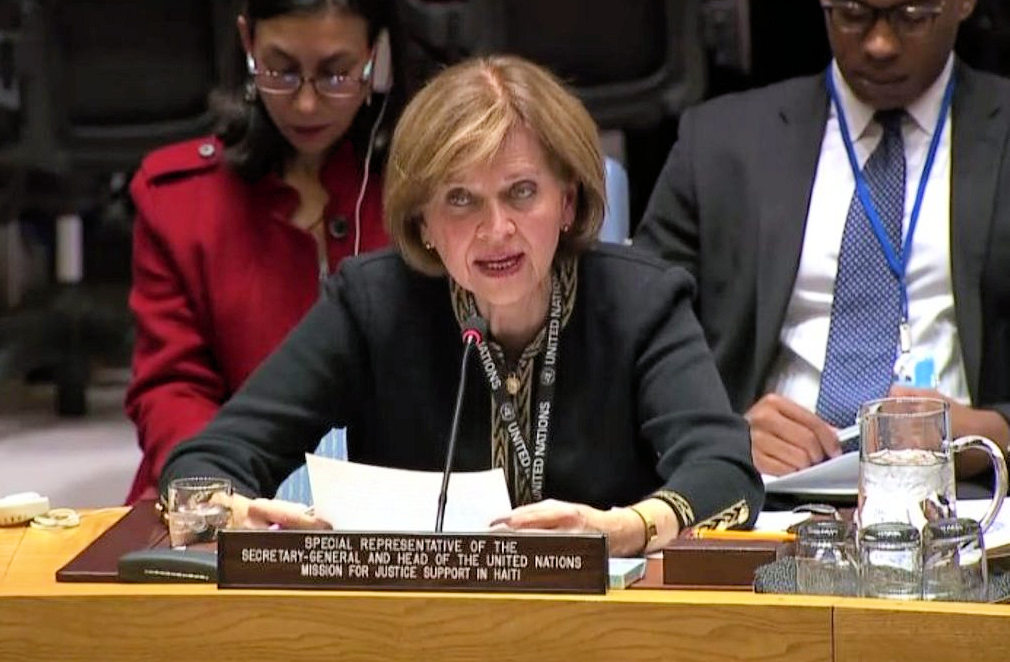
U.S. and other foreign interventions are the cause of Haiti’s ongoing crises.
The first calls for foreign intervention into Haiti came soon after the assassination of Haitian President Jovenel Moïse in Port-au-Prince on Jul. 7. Intervention was justified by the claim that Moïse’s death had created a vacuum of political leadership and authority that would push Haiti into a maelstrom of chaos and anarchy – into what the Guardian announced as a “violent new era.” Only intervention, led by the U.S. and supported by its international partners, could save the troubled republic from an inevitable crisis.
By all accounts, the press projections of Haiti falling to barbarism after the assassination has not happened. But the calls for foreign intervention have continued. These calls have ignored two important and consequential facts. First, previous foriegn interventions have been unmitigated disasters. They have led to long-term military occupations that destroyed the Haitian state and marginalized civil society while leaving tens of thousands of Haitians displaced or dead. Second, and most importantly, Haiti is already under occupation. Calls for “intervention” are not only disingenuous, but actually redundant.
the press projections of Haiti falling to barbarism after the assassination has not happened.
The first U.S. intervention and occupation of Haiti officially began with an echo of the present. In 1915, Haitian president Theodore Guillame Sam was murdered – dragged out of the French legation and killed in the streets – after he had imprisoned and then killed a number of his political opponents. Fearing political chaos, and with a desire to protect U.S. interests, persons, and property, the U.S. landed 300 troops on Jul. 28, 1915, initiating a military occupation that lasted 19 years, until 1934.
But the calls for intervention and the strategies for occupation had long preceded Sam’s murder. In the years leading up to the landing of U.S. Marines in 1915, the National City Bank of New York was becoming increasingly involved in Haiti’s financial affairs. They pushed for control of Haiti’s railroads, ports, the national bank, and the sovereign debt – and they were encouraged by the U.S. State Department, who had adopted the well-known policy of “dollar diplomacy” throughout the Caribbean region . Bank managers served as shadow representatives of the State Department in Haiti.
City Bank officials had already called for U.S. military intervention to protect their Haitian investments before 1914. In 1914, bank vice president Roger Leslie Farnham wrote a memorandum outlining a strategy for occupation, saturated with racial paternalism and ideas of Haitian inferiority, for U.S. secretary of state William Jennings Bryan. The same year, City Bank officials sent a request for U.S. Marines to land in Haiti to move the $500,000 gold reserve from the Banque National d’Haiti in Port-au-Prince to a Wall Street vault. They asserted the action was taken to protect their investments. Haiti’s politicians viewed it as theft, and a deliberate attack on the Republic’s sovereignty.

When intervention and occupation did occur in 1915, the bank consolidated its near-monopoly control of Haiti’s finances, banking, and industry. During the first occupation, the U.S. rewrote the Haitian constitution and installed a puppet president, imposed press censorship and martial law, and brought Jim Crow policies and forced labor to the island. It also initiated a “pacification” campaign against those Haitian militants engaged in armed struggle to protect the republic’s sovereignty. The U.S. military dropped bombs and burned villages, tortured and murdered peasants, and hunted rebel “bandits” for sport.
Of the stated aims of the occupation – building infrastructure, expanding education, and providing internal and regional stability – little was achieved. The longstanding result of the U.S. occupation was the establishment and training of a local police force, the Gendarmerie d’Haïti. Years after the occupation, this police force was used to terrorize the Haitian people.
U.S. troops withdrew in 1934 after a sustained period of protest, begun in 1929 by Haitian students and eventually joined by all classes of Haitians and Haitian allies in the international community.
The U.S. would continue to intervene Haitian affairs, first supporting the brutal dictatorship of Francois “Papa Doc” Duvalier and Jean-Claude “Baby Doc” Duvalier, and then again in 1991 as the CIA bankrolled a coup d’etat against the country’s first democratically elect president, Jean-Bertrand Aristide. The coup was not consolidated because of continuous resistance from the Haitian people. By 1994, U.S. president Bill Clinton’s administration was forced to bring Aristide back to Haiti after three years in exile, with 20,000 troops brought in to quell Haitian resistance. But Aristide was now a hostage to U.S. neoliberal policy. The U.S. troops remained until 1999.

The second occupation of Haiti began in 2004 and was initiated after a coup d’etat sponsored by the U.S., France, and Canada that again dethroned Aristide, who’d been elected Haitian president in 2000. U.S. Special Forces kidnapped Aristide and sent him to the Central African Republic. U.S. President George W. Bush announced afterwards that he was sending U.S. forces to Haiti to “help stabilize the country.” It is clear, as Glen Ford and Peter Gamble remind us, “George Bush didn’t invent U.S. aggression against Haiti; that’s been U.S. policy since 1804.”
The 2004 illegal coup d’état was both enforced and cleaned up with the help of the UN. Much more poorly paid soldiers from mostly Latin America and Asia took over from U.S. forces on Jun. 1, 2004 as the United Nations Stabilization Mission in Haiti (MINUSTAH) for the tasks of military occupation under the guise of establishing peace and security.
A multi-billion dollar operation, MINUSTAH had, at any given time, between 6000 and 12,000 military troops and police stationed in Haiti alongside thousands of civilian personnel. Like the first U.S. occupation, the UN occupation under MINUSTAH was marked by its brutality towards Haitian people. Civilians were brutally attacked and assassinated. “Peace-keepers” committed sexual crimes. UN soldiers dumped human waste into rivers used for drinking water, unleashing a cholera epidemic that killed between 10,000 and 50,000 people.
The Core Group – an international coalition of self-proclaimed non-Black “friends” of Haiti – emerged through the MINUSTAH occupation in 2004. Its stated goal was to oversee Haiti’s governance. Meanwhile, as with the first occupation, the U.S. and MINUSTAH trained Haitian police forces, reintegrating many of the rogue members into these forces. The U.S., in collusion with MINUSTAH and the Core Group, also over-rode Haitian democracy, installing both neo-Duvalierist Michel Martelly and his PHTK party, alongside Martelly’s protege and successor, Jovenel Moïse. Moreover, it was under occupation that Haiti was devastated by the 2010 earthquake; all the pledges of humanitarian aid and assistance and the promises to “build back better” have amounted to nothing, the funds grifted by the Haitian oligarchy and comprador bourgeoisie, as well the international community.
the UN remains a dominant force in Haiti through a new Chapter 6 “consultative” mission
While it is claimed that this occupation officially ended in 2019, with the dissolution of MINUSTAH’s 2017 successor MINUJUSTH (UN Mission for Justice in Haiti) and Haiti’s emergence from the UN Charter’s Chapter 7 status (under which the UN Security Council “determines the existence of any threat to the peace, breach of the peace, or act of aggression” in a given country and can deploy troops), the UN remains a dominant force in Haiti through a new Chapter 6 “consultative” mission: BINUH, the United Nations Integrated Office in Haiti. BINUH has had an outsized role in Haitian internal political affairs. For example, soon after Moïse was killed, its representative, Helen La Lime, asserted that Claude Joseph would remain on as Haiti’s head of government. Ten days later, the “Core Group” changed their mind and demanded that Ariel Henry be Prime Minister. A “new” Haitian government was announced on Jul. 20, 2021 with Henry as leader and without any say from the Haitian people.
It would seem that the goal, and perhaps success, of this occupation has been to quell the last vestiges of the mass movement that emerged with the fall of the Duvalier dictatorship and culminated in the 1990 election of Jean Bertrand Aristide. The objective was to also completely and fatally destroy the Haitian state and with that, the turning of Haiti into a permanent vassal state. In this, the self-hating comprador bourgeoisie, the poodles for white supremacy, have played a significant role. It is noteworthy that, in the wake of Moïse’s assassination, the comprador bourgeois lapdogs (such as Claude Joseph, Joseph Lambert, Ariel Henry) as well as the non-Black oligarchs (such as Reginal Boulos) rushed first to get the blessings of their white overlords, representatives of the BINUH, the Core Group, and the U.S. State Department.
For Haiti, both the first occupation, in 1915, and the second, in 2004, were unmitigated disasters. Both were premised on the idea that not only was Haiti falling into chaos and anarchy, but with the deeply racist notion that Haitians are unable to govern themselves. Be it under watch of U.S. Marines, a multinational UN force, or an international cohort of technocratic experts in security and democracy, it seems likely that the ongoing, informal second occupation will be intensified by a formal foreign military intervention.
The occupation will only end with the complete withdrawal of the imperial powers from Haiti.
An earlier version of this article was first published in Black Agenda Report. Peter James Hudson is a writer, editor, and historian who teaches Black Studies at UCLA. He is the author of Bankers and Empire: How Wall Street Colonized the Caribbean. Jemima Pierre is a contributor to Black Agenda Report, the Haiti/Americas Coordinator for the Black Alliance for Peace, and a Black Studies and anthropology professor at UCLA.









